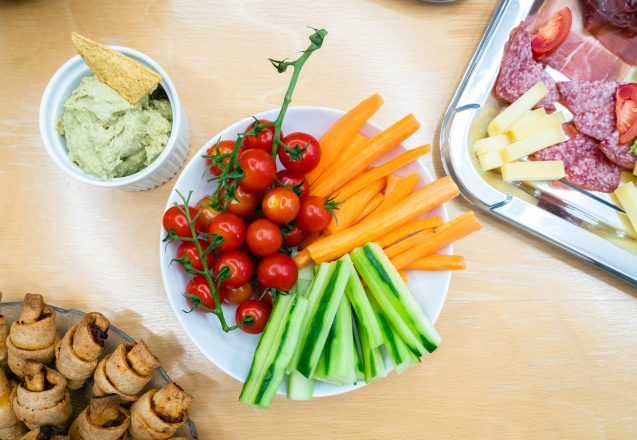Don’t Wait For The New Year To Start It Right
 Most people make resolutions for the new year, but often find them way too ambitious to achieve. Rather than waiting and starting with a list that’s long and intimidating, don’t wait for the new year to make a change, start it right away. Living a healthy lifestyle begins with a small step. Why wait to start when you can create some healthy habits that will also help you through the holiday season.
Most people make resolutions for the new year, but often find them way too ambitious to achieve. Rather than waiting and starting with a list that’s long and intimidating, don’t wait for the new year to make a change, start it right away. Living a healthy lifestyle begins with a small step. Why wait to start when you can create some healthy habits that will also help you through the holiday season.
Just keep moving.
Exercise is important and you can get more by making a few changes. When you’re out shopping or doing the chores at home, make that time an exercise time. You won’t be using precious time. In fact, you’ll probably get tasks done faster. Circling the parking lot when you’re shopping will help you find the best parking spot, but it burns extra fuel and doesn’t give you an opportunity for extra exercise. Park in the first spot you find and walk a little further, making it a brisker pace in the process. Don’t wait for elevators, take the stairs and when you walk somewhere, make it at a fast pace.
Start switching to a healthier diet.
The holidays are definitely not a time to start a diet. Luckily, eating healthy isn’t dieting. Start by planning healthy snacks to prevent overdosing on all those sweet treats you associate with holiday time. Rather than gorging on special holiday treats, freeze them and munch on one a week throughout the year. Knowing you’ll have some for later will diminish your desire to eat them all now. Plan healthy meals and make them ahead for a whole week, so you won’t have to stop for a quick drive through meal during the week.
Make holiday dinners healthier.
Sure, everyone eats way too much on the holidays, but what if the food you brought was high in nutrition and taste, yet still low in calories. Overindulging in that case isn’t as much of a problem. Slim down some of the favorites by making substitutions, such as wild or brown rice for white rice. Even appetizers can be healthier by making recipes like eggplant ricotta appetizers or an avocado-feta dip.
- Get plenty of sleep. Studies show that lack of sleep boosts the hunger hormone, ghrelin and diminishes the one that leaves you full, leptin.
- Carry a bottle of water with you. It may be winter and the holidays, but staying hydrated is important. If you find yourself dragging, try a bottle or glass of water and you may find that’s all you needed. Mild dehydration makes you tired.
- If you can’t start a program of regular exercise at the gym, try walking. You can break up the walks to ten minutes each and do them throughout the day.
- Give yourself a gift of good health. Whether you include it on your wish list or give yourself a gift, you’ll find a few sessions with a personal trainer can get your fitness program off to a great start. Next Level Fitness even offers the first session free.



 Whether you feel like hiding in the closet when holidays roll around or simply love the holidays, but find you can’t seem to keep up with all the demands, it’s time to make changes. You can keep your holidays happy and healthy in Irvine, CA, by planning ahead, taking time for yourself and focusing on what’s really important in your life. That’s easier to say than to do. After all, where do you find time for yourself when there are so many tugs on your time, making it impossible to keep up the pace.
Whether you feel like hiding in the closet when holidays roll around or simply love the holidays, but find you can’t seem to keep up with all the demands, it’s time to make changes. You can keep your holidays happy and healthy in Irvine, CA, by planning ahead, taking time for yourself and focusing on what’s really important in your life. That’s easier to say than to do. After all, where do you find time for yourself when there are so many tugs on your time, making it impossible to keep up the pace.
 Never use the excuse that you can’t eat healthy because it’s too hard, especially when you have this guide that makes healthy eating made simple. The first, and simplest, rule to remember, but not the easiest to follow, is to cut out added sugar. Cutting out sugar is tough for two reasons. First, it’s in almost everything. The next time you grab the catsup for your fries, check the ingredients. You’ll notice the high fructose corn syrup—a type of sugar—is high on the list. The easiest way to avoid it is to eat more whole foods, where you control the ingredients.
Never use the excuse that you can’t eat healthy because it’s too hard, especially when you have this guide that makes healthy eating made simple. The first, and simplest, rule to remember, but not the easiest to follow, is to cut out added sugar. Cutting out sugar is tough for two reasons. First, it’s in almost everything. The next time you grab the catsup for your fries, check the ingredients. You’ll notice the high fructose corn syrup—a type of sugar—is high on the list. The easiest way to avoid it is to eat more whole foods, where you control the ingredients.
 You’ve been told for ages that eating fat will definitely make you sick, but unfortunately, the mega study that supported that was paid for by the sugar industry. The truth is that sugar consumption, rather than fat consumption is more lethal to your health. It can cause metabolic disease and the most common form of metabolic disease is diabetes. Eating excess sugar can cause metabolic syndrome. That syndrome includes insulin resistance, the precursor to type II diabetes. It also leads to obesity including visceral fat—abdominal fat, high cholesterol, inflammation and high blood pressure.
You’ve been told for ages that eating fat will definitely make you sick, but unfortunately, the mega study that supported that was paid for by the sugar industry. The truth is that sugar consumption, rather than fat consumption is more lethal to your health. It can cause metabolic disease and the most common form of metabolic disease is diabetes. Eating excess sugar can cause metabolic syndrome. That syndrome includes insulin resistance, the precursor to type II diabetes. It also leads to obesity including visceral fat—abdominal fat, high cholesterol, inflammation and high blood pressure.
 If you haven’t heard of intermittent fasting before and think it’s new, be prepared to be surprised. There have been studies that date back a few centuries. One scientific study conducted on rats in the 1940s showed that intermittent fasting could prolong life. It kept the fasting rat looking younger and free of some of the diseases rats face as they aged. Great religious leaders have fasted for both body and spirit, so it does come with a history. However, intermittent fasting is different from the traditional fasting of the ancients. It’s all about when you eat.
If you haven’t heard of intermittent fasting before and think it’s new, be prepared to be surprised. There have been studies that date back a few centuries. One scientific study conducted on rats in the 1940s showed that intermittent fasting could prolong life. It kept the fasting rat looking younger and free of some of the diseases rats face as they aged. Great religious leaders have fasted for both body and spirit, so it does come with a history. However, intermittent fasting is different from the traditional fasting of the ancients. It’s all about when you eat.
 Losing weight takes more than just eating or drinking a magic formula. It takes adjusting your diet so it’s healthier and exercising regularly. However, there’s a new fad in weight loss called detox water. Some of my clients in Irvine, CA even use detox water recipes for weight loss. Does it work? The answer is yes and no. Detox water is water that’s been infused with fresh herbs, fruits and vegetables to add flavor and even a few extra nutrients. If you’re drinking it instead of a soft drink or even fruit juice, you’ll be cutting calories by drinking detox water and cutting sugar. So, yes, in that way it can be exceptional for aiding in weight loss.
Losing weight takes more than just eating or drinking a magic formula. It takes adjusting your diet so it’s healthier and exercising regularly. However, there’s a new fad in weight loss called detox water. Some of my clients in Irvine, CA even use detox water recipes for weight loss. Does it work? The answer is yes and no. Detox water is water that’s been infused with fresh herbs, fruits and vegetables to add flavor and even a few extra nutrients. If you’re drinking it instead of a soft drink or even fruit juice, you’ll be cutting calories by drinking detox water and cutting sugar. So, yes, in that way it can be exceptional for aiding in weight loss.
 Clients who visit us in Irvine, CA, often have big goals. Some that aren’t achievable in less than a few years. For these people who work to help them break down those goals and set monthly goals. That doesn’t negate that “big goal.” It just provides the steps to help them achieve those goals. Why would you want to do that? There’s a number of reasons. One of the biggest reason is motivation.
Clients who visit us in Irvine, CA, often have big goals. Some that aren’t achievable in less than a few years. For these people who work to help them break down those goals and set monthly goals. That doesn’t negate that “big goal.” It just provides the steps to help them achieve those goals. Why would you want to do that? There’s a number of reasons. One of the biggest reason is motivation.
 You probably notice when you don’t brush your teeth in the morning before you leave for work. In fact, if you forgot, you may even stop at a store to buy a toothbrush and toothpaste to brush when you get there. That’s because it’s become a habit to brush before you leave and if occasionally you forget you simply don’t feel right. You can follow a quick morning routine to help you get into shape, lose weight and stay fit. Don’t try to do everything at once.
You probably notice when you don’t brush your teeth in the morning before you leave for work. In fact, if you forgot, you may even stop at a store to buy a toothbrush and toothpaste to brush when you get there. That’s because it’s become a habit to brush before you leave and if occasionally you forget you simply don’t feel right. You can follow a quick morning routine to help you get into shape, lose weight and stay fit. Don’t try to do everything at once.
 No matter what the weather, I carry a water bottle everywhere. It’s partially because I like water. Somewhat because I get thirsty frequently, but also because water boosts my energy level without the high and low repercussions of a sugary soft drink. Water is good for you too. In fact, the brain is composed mostly of water, so you can see how staying hydrated can keep you more alert. The heart and brain contains 73 % water, the lungs have 83% and muscles and kidneys contain 79%.
No matter what the weather, I carry a water bottle everywhere. It’s partially because I like water. Somewhat because I get thirsty frequently, but also because water boosts my energy level without the high and low repercussions of a sugary soft drink. Water is good for you too. In fact, the brain is composed mostly of water, so you can see how staying hydrated can keep you more alert. The heart and brain contains 73 % water, the lungs have 83% and muscles and kidneys contain 79%.
 It’s hard enough to lose weight, but nearly impossible to prevent pounds from returning. Keeping pounds off is especially difficult if you dieted. Dieting doesn’t work because it always ends. At that point people go back to the eating habits that put on the weight in the first place. Rather than dieting to lose weight, people need to make lifestyle changes to not only take off pounds but keep them off permanently.
It’s hard enough to lose weight, but nearly impossible to prevent pounds from returning. Keeping pounds off is especially difficult if you dieted. Dieting doesn’t work because it always ends. At that point people go back to the eating habits that put on the weight in the first place. Rather than dieting to lose weight, people need to make lifestyle changes to not only take off pounds but keep them off permanently.